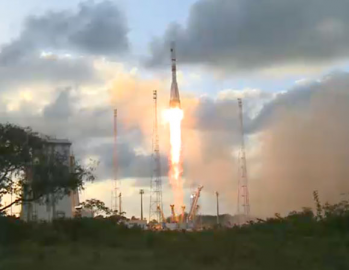Soyuz orbits Sentinel-1A on 7th successful launch from French Guiana
2014-04-03 The first satellite of Europe’s Copernicus programme was sent aloft today, Thursday 3 April, by a Soyuz launcher from the Guiana Space Centre as scheduled at 18:02 local time (23:02 CET).
Soyuz launcher lifted off on 3 April 2014 from the Guiana Space Centre at 23h02 (CET) with Sentinel-1A satellite on board. Credits: ESA/CNES/Arianespace/Optique vidéo du CSG.
Sentinel-1A will deliver day/night, all-weather Earth imagery. It will be joined in early 2016 by a 2nd satellite, Sentinel-1B, to form a constellation capable of scanning the entire surface of the globe every 6 days.
Initiated in 2005, Copernicus (formerly GMES) is a vast global environmental monitoring programme led by the European Union and developed in partnership with ESA and member states. The space component of Copernicus will rely on a constellation of Sentinel satellites as well as French satellites—Pleiades, SPOT, Jason-2 and Megha-Tropiques—operated by CNES.
Soyuz launcher lifted off on 3 April 2014 from the Guiana Space Centre at 23h02 (CET) with Sentinel-1A satellite on board. Credits: ESA/CNES/Arianespace/Optique vidéo du CSG.
For a little more insight into the project see this:http://www.cnes.fr/web/CNES-en/11229-gp-soyuz-orbits-sentinel-1a-on-7th-successful-launch-from-french-guiana.php

 Search
Search


